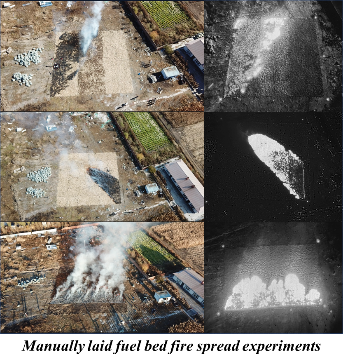The National Key R&D Program of China “Key Technologies and Equipment for Ground-Air Collaborative Fighting of Forest and Grassland Fires”, led by Prof. Jie Ji from SKLFS, has carried out fire spread experiments of manually laid fuel with an area of 900m2 and prescribed burning experiments with an area up to 100,000m2.

In the manually laid fuel fire spread experiments, the fuel types (corn stalks, walnut leaves, etc), fuel moisture content and ignition modes (single-point ignition, multi-point ignition, linear ignition, etc.) were changed to construct different fire spread scenarios. Multi-terminal equipment, including UAVs and ground video towers, etc., have been used to record fire spread process data, such as meteorological, topographical, and combustible parameters. The prescribed burning experiments were carried out in Lesser Khingan Mountains, China, and included several meadow fire spread scenarios with an area of 40,000m2 to 100,000m2. In particular, a fleet of drones was organized to collaboratively collect large-scale fire data.

A series of data-driven prediction methods have been established to solve the problem of defects in actual observation data, such as non-continuous, asynchronous, and unknown observation errors. The purpose of these experiments is to build a sample library of multi-granular spatiotemporal parameters of fires for coordinated monitoring on the ground and in the air, providing real fire environment measurement parameters for the basic theory of fire spread, and to verify the effectiveness of the prediction models established through simulation data before. This work has been published in the International Journal of Wildland Fire. The developed technologies have been applied to analyze the wildfire occurred in Kunming, China, on April 12, 2024, successfully simulating the spread of the fire.

